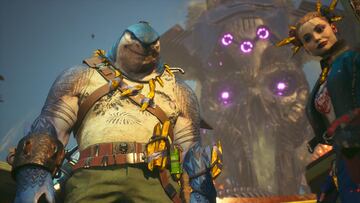Rocksteady Studios
Suicide Squad: Kill the Justice League - the best mess of a game you can get
Is Suicide Squad: Kill the Justice League as bad as we’ve made it to be? After playing through to the endgame, we have conflicting opinions on it. Here are our thoughts.
Originally announced in 2020 and with many delays after that, Suicide Squad: Kill the Justice League has had a rough time at the stage ever since its inception. With a bombastic title that goes against what many Rocksteady fans had expected after the amazing Arkham trilogy, an unfortunate exit of many of the senior developers, and the game being absolutely blasted for the decision of making it a live service game, the title has been fighting an uphill battle at almost every turn.
But when you strip it down to its most basic elements, going past the superficial resentment of this not being more Batman, or the heavily rumored Superman game that many wanted, how bad is it really? Is the live service tag such a bad fit for the kind of game the people at Rocksteady wanted to make?
We invested enough time to take our time with the campaign, going from beginning to endgame, and while we agree that the game has its fair share of problems, we can’t deny that there is some fantastic gameplay mechanics at the core of the experience, highly elevated by state of the art graphics and art direction, a fantastic script and story with top tier voice acting like very few manage to do, and some of the best movement in a video game this side of Mirror’s Edge.
But is it good? Well… it’s complicated
A shark, a psycho, a killer, and an Australian walk into Metropolis…
Let’s make something clear: if you wanted to see a continuation to the Arkham story about a dark brooding Batman who seemingly returns from the dead to join the Justice League, this isn’t it. While it does take place in the same universe as Rocksteady’s past Batman games, that’s about as close as it’ll get to that. And I think that’s a good, if extremely bold, decision.
The story centers around the eponymous Suicide Squad, DC’s team of unhinged villains and anti-heroes rounded up by the imposing Amanda Waller, and given an impossible task such as killing the Earth’s biggest heroes. Having gained a lot of popularity in the past decade thanks to James Gunn and David Ayer’s live-action adaptations and some fantastic animated movies, some fans might already be familiar with the concept. It’s typically a way of showing off some of DC’s more unknown characters, and letting them shine while also showing a darker side of the world of Gods and Heroes.
This team’s (initial) lineup consists of Deadshot (whose appearance actually comes with its own as-of-yet unresolved mystery), Captain Boomerang (the above-mentioned Australian with a sharp and not really practical weapon choice), Harley Quinn (back from the Arkham trilogy after five years locked up in the Asylum), and of course, King Shark (who is a shark). Except unlike many expected, their characterizations are deep and complex, each with their own motivations that actually affect the plot. Each of them start out as forceful allies, yet over the course of the game become a somewhat less mediocre squad. But it is their dialog and interactions that carry the story, and none of them are treated as one-note caricatures.
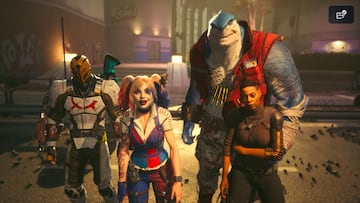
Alongside them, Amanda Waller actually manages to get an entire support squad for the main 4 killing machines, and although most of them end up becoming simple storefronts their interactions help tremendously.
Without entering spoiler territory, the plot of the game is also a strong enough hook to keep you wondering what’s going to happen next. It is undeniable that Suicide Squad KTJL is one of the best-written games of the last five years, and that’s saying a lot. The story is intriguing, full of twists and turns, with each confrontation between the League and the Squad being both humorous and extremely intimidating.
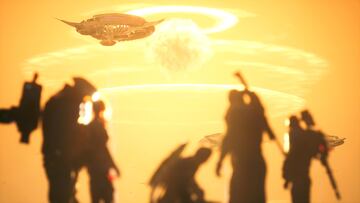
However, it’s also a bit frontloaded, with some of the best work taking place near the beginning. The live-service nature of the game unfortunately makes the final acts feel a little bit incomplete, but it’s still commendable that they managed to cram so much narrative into this style of gameplay.
Break-neck speed and crunchy guns
So what do you actually do when playing? The main gameplay loop is simple: traverse Metropolis to a mission area, complete a quick combat challenge, typically with special rules or restrictions, and move on to the next one. It is true that Rocksteady fumbled many thing in the design of this loop, especially if you’re playing on your own with the rest of the Squad being bots: there are very few types of missions, which you will be repeating over and over again during the campaign. By the 10th hour, even while the story gets larger and larger, encounters can begin to get samey as you’ll be fighting the same kinds of enemies every time, always on very small rooftops.
However, when the combat clicks, it clicks hard: combined with the fantastic movement mechanics (unique to each of the members of the squad), the act of fighting in Suicide Squad KTJL can be exhilarating. Captain Boomerang uses a Speed Force gauntlet and his boomerang to teleport and speed around the arena, easily gaining the positional advantage. Deadshot’s jetpack can seem limited at first, but when you master it you’ll be zipping in the distance, raining headshots from afar and repositioning with ease.
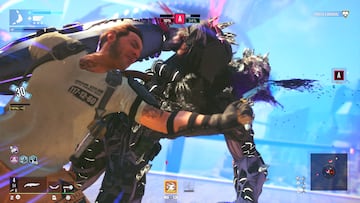
King Shark is surprisingly quick for his size. He’s the only one of the team that actually has superpowers (the others stole equipment from the Hall of Justice) and he uses it to jump into combat and obliterate enemies from within, as he’s a bit of a tank. And Harley Quinn has a grappling gun and a Batdrone, allowing her to swing around the map at her leisure. She’s has the most complex movement of the bunch, but once you master it it can make her extremely survivable and quick.
Movement also gives you different resources that charge up traversal attacks (area of effect) and Suicide Strikes (single enemy finishers), which means that you’re supposed to keep moving as much as possible. And to boost this feeling, if you stay still for a moment enemies rush at you and pelter you with bullets.
Now that you know how movement works, you start to pair it with a small but effective arsenal of weapons and you get an extremely fast paced combat system. At the time of release, Suicide Squad only has 6 weapon types (handguns, SMGs, Shotguns, Assault Rifles, Sniper Rifles, Heavy Weapons/Gatling Guns). Each character has access to three of these type, but they can only carry two of them. However, there are various “manufacturers”, with weapons behaving differently enough according to their type and make that you’ll be sure to find one that works with you. I enjoy going around as Boomerang with a shotgun that reloads shell by sheel but hits hard and a Sniper just in case, but I’ve encountered all types of mixtures.
Then you start to get into the minutia of combat, and you find that there are even more systems in place: you all have counters in the form of a special shot, so you can parry enemies from any distance. Shooting enemies on the legs can open them up to a shield drain attack, which is the only way to heal, but melee attacks can also work as openers to juggle monsters and shoot them from a distance. You start to get elemental effects for your melee weapons, then your grenades, and each of them has effects that can completely modify the flow of combat, and even after you’re done with the story you continue unlocking new equipment slots and new tiers of weapons and armor, with plenty of more skills from your skill trees left to unlock.
RPG elements can be good, but this time they #&%)’d up
So those are the basics of combat. Without anything else, it’s extremely fun. At almost every point I was playing I found myself trying to get in as big a fight as possible when roaming the map. But dare to look a bit deeper into the systems and…
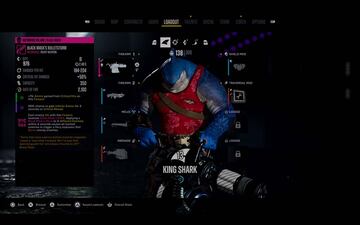
There they are. The dreaded spreadsheet of numbers that only gets more and more complicated as the game goes on. The example in the image above is a pretty standard weapon, only being an “epic” tier of rarity, but that means that it’s got plenty of space to get many more lines of text explaining overly specific effects and skills that are extremely tedious and confusing to read through, at least if you’re only there for the action.
Sudednly, you can get a shiny new legendary weapon and start using it, only to find out that you’re not doing any damage to the last enemy of a wave. You go in and check the weapon, and it turns out it specifically does no damage to that one type of monster. But it crits every time against another type. Or you pick up a weapon that launches enemies into the air and causes an area of effect slo-mo bubble around them, except it only does damage when a crit hits. Effects like this are dime a dozen and require you to carefully read all of the loot you get, and slows the game to a halt.
As if that werent enough, the RPG elements of the game mean that certain weapons can be outclassed by others very quickly, even if you love how they work. Or you can find an extremely good one and nothing else you find is stronger, as happened to me with a legendary Linebacker Shotgun that I got on the first mission reward. All the way to the endgame, even above higher tiers of weapons for some reason.
There doesn’t seem to be a good balance for the loot that you get, and as you advance loot starts getting diluted because there are 7 categories of equipment you can wear, and at most you get two or three random drops from every mission you complete. Monsters seldomly drop weapons, but they’ve never been high enough tier, mostly dropping uncommon and epic weapons even at higher tiers.
And then there’s the levels and the skill tree. Every character can go up to level 30, unlocking a new skill point every time they level up, which can be exchanged for a new “skill” in one of three skill trees. Except, there is not much choice on what you get: you get one skill point exclusive to one of the skill trees every level, always on the same order, and only usable in its own skill tree. This means that you can only advance a skill tree every three levels, and unless you have a choice at the same tier of the skill tree you don’t get to choose what you get.
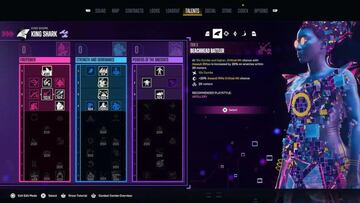
Even worse is the fact that these upgrades are all extremely boring, consisting only of percentile augments to different types of damage, or situational boosts (represented by percentile numbers) that activate with the combo system. Further down the line is as if they didn’t know what to do, and you start getting skills like “if you hit enemies, you get extra combo”, or “if you lose your combo, you recharge all of your combo”.
The game even marks skills with different “playstyles”, but in reality there isn’t much of a change between all of these upgrades. At best, these skills help make the screen more cluttered with effects and animations, and at worse they are egregiously inconsequential to the actual game, as you don’t have a choice of when or if you get the boosts or not.
But what happens if you level up to the max level? Spoiler alert, you probably won’t reach the max level until after the end of the main story, as there aren’t enough sidemissions to do so with even a single character, let alone four. But during the endgame, if you reach max level 30, you are rewarded with “Squad Skills”: a new grid of XP-based level ups that unlocks… percentage upgrades to every other skill in the game. But these ones apply to every character at the same time.
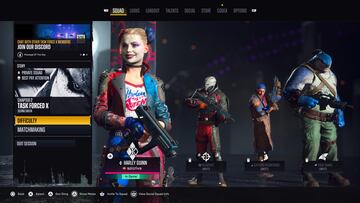
And so, the game becomes a boring grindfest to keep up with future content, which will surely result in players dropping off for not being able to have enough power boosts to handle whatever challenge could come in the future. The though of having to do so for every new character that has been promised is also a little bit exhausting, considering that they’re supposed to come with their own “skill trees” and levels.
The cold, hard, violent truth
So then, is Suicide Squad: Kill the Justice League a good game, or a bad game?
Well, it’s both. On one hand you have an incredible story, great characters with fun, unique movement options and fantastic combat that can keep you entertained if only for the adrenaline that it produces in your brain. You can let yourself play on instinct and suddenly you’ll find yourself in a flowstate like very few games can do. There is a rhythm to the fighting that when done well is enough to keep you coming back, with the real reward for main missions being the progression of a fun story.
But on the other hand you have the glaring meddling of executives hungry to have their own Fortnite, their own Destiny 2 or the next World of Warcraft. The exhausting, overly complicated and grindy mechanics of a live-service title completely clash with what the people at Rocksteady managed to create. It is abundantly clear that there once was a different kind of game than what we got, one centered completely around wacky characters and coop yes, perhaps even gunplay (which ended up being the main gripe for many fans). But something terrible happened along the way, and the developers did everything in their power to create a satisfying experience with what they had to work with.
There’s even more fumbles here that we could go on and on about:
- The boss fights with the league vary greatly in their quality, with some being utterly disappointing and others being huge spectacles. The final boss is even a rehash of a previous fight, but with every single mechanic added to it that ironically makes it the most exciting encounter in the game.
- The game never shuts up. There is not a single moment of silence, with enemy radios blaring, the evil Justice League teasing and mocking you, Waller shouting orders, the Squad talking amongst each other, the support squad quipping, and Riddler. Oh how awful Riddler is.
- Riddler is back! Which some people will love, but that means trophies and obtuse environmental riddles are spread around the city, and Riddler won’t shut up about them at any point in the game.
- So many fun easter eggs that all dig deep into DC history
- Heartfelt, honest tributes to both Kevin Conroy and Arleen Sorkin
- King Shark is just THE BEST. 10/10, should get his own game.
- An awfully crowded HUD, that can thankfully be personalized to your tastes
- The premium outfit bundle isn’t complete, still forces you to buy an an additional bundle for colors and skins.
- The endgame right now is doing the same 3 types of missions over and over again, and it’s definitely not worth it.
So should you play it? If you’re one of the many that feel offended by the fact that it’s not another Rocksteady Batman game, or that is angry at the fact that you kill the heroes in a Suicide Squad game, then no.
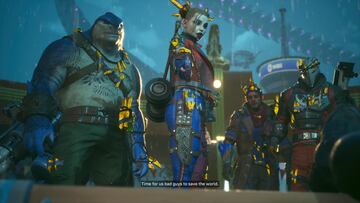
But if you want a fun story and a good time with a group of friends, and you manage to get enough time between all of the mayor releases to have them sit down together and do a few missions at a time, absolutely. It’s like a more violent Mario Party where the minigames are all about shooting aliens. Just ignore all of the RPG fluff, and don’t fall prey to the FOMO effect.
Come on, do it for King Shark. Look at him:
